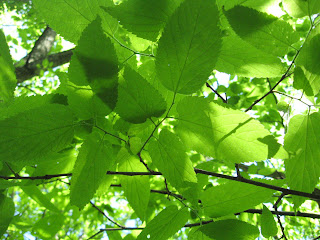Hackberry: The Teenage Years
I was going through some of my photos from this past summer (preparing to organize and identify them), when I came across a picture of a tree with some very interesting bark.
I had a vague feeling of recognition when I took this picture, but I couldn't quite pin it down. After being a teaching assistant for a botany class this semester, however, I remembered what it was the second time around: American hackberry (Celtis occidentalis).
What's the easiest way to remember this tree? Definitely the bark: it's gnarled and warty, with furrows. As the tree gets older, it gets more warty and just a tad bit smoother. It hasn't reached this stage yet, so I would call this tree a teenager.
The leaves are serrate (they have little teeth on the edges), and are alternatively arranged on the stem.
I had a vague feeling of recognition when I took this picture, but I couldn't quite pin it down. After being a teaching assistant for a botany class this semester, however, I remembered what it was the second time around: American hackberry (Celtis occidentalis).
What's the easiest way to remember this tree? Definitely the bark: it's gnarled and warty, with furrows. As the tree gets older, it gets more warty and just a tad bit smoother. It hasn't reached this stage yet, so I would call this tree a teenager.
The leaves are serrate (they have little teeth on the edges), and are alternatively arranged on the stem.
American hackberry is found in the West and Midwest, and is relatively common in Ohio. When its leaves fall off in the autumn, you can sometimes find galls on the leaves caused by a Psyllid insect (it's related to cicadas and aphids). Due to these little insects, the leaves can become as warty as the bark! For more information about the galls, check out the University of Nebraska-Lincoln Extension site.
Interestingly enough, this tree has been in my backyard for a while now and I never noticed it before. If you haven't found a theme from my blog yet, consider this: get out there and start observing! There's still so much to explore.





Comments
Post a Comment